Zero Zone 2RMZC30 Installation Manual
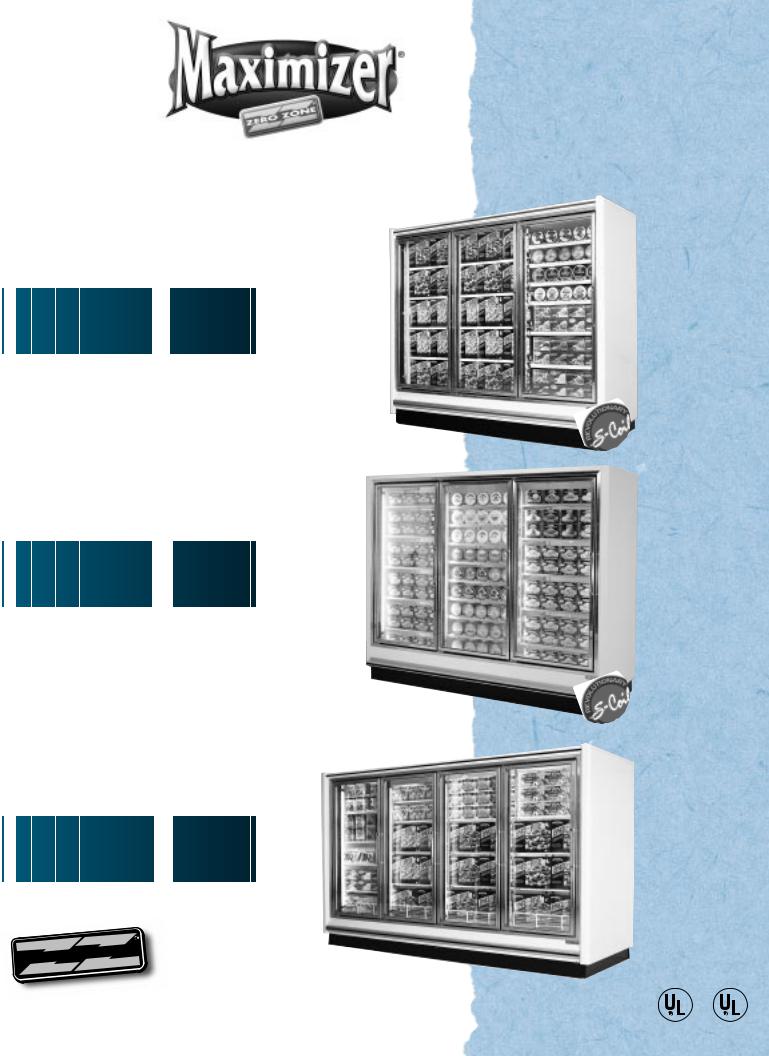
Display
INSTALLATION Freezers and OPERATING INSTRUCTIONS for

 RMZC30
RMZC30


 Series
Series



























 RMZP30
RMZP30


 Series
Series




























 RMZP24
RMZP24


 Series
Series


























ZERO |
ZONE |
|
|
|
|
|
|
Zero Zone, Inc. • 110 N. Oakridge Dr. • North Prairie, WI 53153-9792 |
CRMA |
|
|
Certified |
C |
||
1-800-247-4496 • FAX: 1-414-392-6450 • www.zero-zone.com |
|
||
|
06995M21000129 |
||

TABLE OF CONTENTS |
|
SUBJECT |
|
GENERAL INFORMATION ............................................................................. |
1 |
INTRODUCTION ........................................................................................................... |
1 |
INSPECTION ................................................................................................................. |
1 |
LOCATION .............................……………................................................................... |
1 |
INSTALLATION .........................................….................................................. |
1 |
LEVELING ...................................................................................................................... |
1 |
JOINING FREEZERS .......................................................…........................................... |
3 |
DRAIN LINE ...............................................…............................................................... |
3 |
CART BUMPER ............................................................................................................ |
3 |
REFRIGERATION ........................................................................................... |
3 |
GENERAL ......................................................…........................................................... |
3 |
REFRIGERANT PIPING .........................................................................….................... |
5 |
TEMPERATURE CONTROL ........................................................................................... |
5 |
TEMPERATURE CONTROL ADJUSTMENT ........................................…................ |
5 |
LEAK CHECK-EVACUATION-CHARGING ..............................................…................ |
5 |
ELECTRICAL ..................................................................................…............. |
6 |
DEFROSTING ................................................................................................. |
6 |
GENERAL ..........................................................................…....................................... |
6 |
ELECTRIC DEFROST ...............................................….................................................. |
7 |
GAS DEFROST ....................................……………....................................................... |
7 |
LIMIT THERMOSTAT ..........................................................…........................................ |
7 |
USER INFORMATION .................................................................................... |
8 |
CLEANING ......................................................…......................................................... |
8 |
SHELF LOCATION ........................................................................................................ |
8 |
LOADING THE FREEZER .............................................................................................. |
8 |
LIGHT SWITCH .............................................................................................................. |
8 |
SERVICE ........................................................................................................ |
8 |
CART BUMPER ............................................................................................................. |
8 |
EVAPORATOR ............................................................................................................. |
8 |
EXPANSION VALVE ..................................................................................................... |
8-9 |
DEFROST HEATER ELEMENT ........................................................................................ |
9 |
RMZC/P30 HEATER ELEMENT REMOVAL .......................................…...................... |
9 |
RMZP24 HEATER ELEMENT REMOVAL ....…………........................…....................... |
9 |
EVAPORATOR FANS ................................................................................................... |
9 |
RMZC/P30 FAN REMOVAL ....................................................................................... |
9 |
RMZP24 FAN REMOVAL ...…..................................…............................................... |
9 |
LIGHTS ..............................................................................................…………………. |
9-10 |
RMZC30, RMZP30, RMZP24

BALLASTS ..............................................................…......................…………………… |
10 |
||||
ALTERNATE LIGHTING - T8 ..............................................................…........................ |
10 |
||||
TABLES |
|
|
|
|
|
TABLE 1 RMZC/P30 LINE SIZE -14 F R502, R404a, R507 ........……........…............... |
11 |
||||
TABLE 2 RMZC/P30 LINE SIZE -20 F R502, R404a, R507 ..................….................... |
12 |
||||
TABLE 3 RMZC/P30 |
LINE SIZE -14 F R22 |
...............…...............….............................. |
13 |
||
TABLE 4 RMZC/P30 |
LINE SIZE -20 F R22 |
...................….....................….................... |
14 |
||
TABLE 5 RMZP24 LINE SIZE -14 F R502, R404a, R507 ...................…........................ |
15 |
||||
TABLE 6 RMZP24 LINE SIZE -20 F R502, R404a, R507 .............................….............. |
16 |
||||
TABLE 7 RMZP24 |
LINE SIZE -14 F R22 |
...................................…..............…................ |
17 |
||
TABLE 8 RMZP24 |
LINE SIZE -20 F R22 |
........................…..............................…........... |
18 |
||
FIGURES |
|
|
|
|
|
FIGURE 1 LEVELING CASES PRIOR TO JOINING .........................…..............……... |
2 |
||||
FIGURE 2 CAULKING CASES TO BE JOINED ....……....................…..............……... |
2 |
||||
FIGURE 3 JOINING 24” DOOR REACH-IN FREEZERS .........................….......……... |
2 |
||||
FIGURE 4 JOINING 30” DOOR REACH-IN FREEZERS ...............……..............……... |
4 |
||||
FIGURE 5 INSTALLING TEE STRIPS …………………........................…..............……... |
4 |
||||
FIGURE 6 INSTALLING THE CART BUMPER ………........................…..............……... |
4 |
||||
FIGURE 7 TEMPERATURE CONTROL SETTINGS ….........................…..............……... |
5 |
||||
FIGURE 8 TYPICAL TEMPERATURE CONTROLS ….........................…..............……... |
6 |
||||
FIGURE 9 DEFROST FREQUENCY AND TERMINATION ..................................……... |
7 |
||||
FIGURE 10 RMZC30 SPECIFICATION SHEET ...............................….......................... |
19-20 |
||||
FIGURE 11 RMZP30 SPECIFICATION SHEET ............................................................. |
21-22 |
||||
FIGURE 12 RMZP24 SPECIFICATION SHEET ............................................….............. |
23-24 |
||||
FIGURE 13 RMZC/P30/24 ELECTRIC DEFROST WIRING DIAGRAM .…................. |
25 |
||||
FIGURE 14 RMZC/P30/24 HOT GAS DEFROST WIRING DIAGRAM ...........…........ |
26 |
||||
FIGURE 15 RMZC/P30/24 WIRING DIAGRAM FOR TIME/TEMPERATURE DEFROST |
27 |
||||
FIGURE 16 RMZC/P30 ELECTRIC DEFROST ASSEMBLY ....................…................... |
28 |
||||
FIGURE 17 RMZC/P30 HOT GAS DEFROST ASSEMBLY ........................................... |
29 |
||||
FIGURE 18 RMZP24 ELECTRIC DEFROST ASSEMBLY .................……....................... |
30 |
||||
FIGURE 19 RMZP24 HOT GAS DEFROST ……...........…............................................ |
31 |
||||
WARRANTY ................................……………….............................................. |
32 |
||||
RMZC30, RMZP30, RMZP24

GENERAL INFORMATION
Introduction
The information contained in this manual pertains to the following Maximizer display freezers: RMZC30, RMZP30 and RMZP24. These cases are used for merchandising frozen food or ice cream. The RMZC30 and RMZP30 cases have 30-inch wide doors and utilize the revolutionary new S-coil. The RMZP24 has 24” wide doors and utilizes our traditional oversized coil. Zero Zone has made every effort to produce refrigeration equipment of the highest quality using state-of-the-art components.
These display freezers were designed to operate in an air-conditioned store where the temperature is maintained at 75°F or lower and the relative humidity is 55% or lower.
Inspection
These display freezers were carefully factory-tested, inspected and properly packed to ensure delivery in the best possible condition. The equipment should be uncrated and checked for damage immediately upon delivery. ALL CLAIMS FOR DAMAGES MUST BE FILED
WITH THE TRANSPORTATION COMPANY - NOT WITH ZERO ZONE. The carrier will supply necessary report and claim forms.
Location
These freezers must not be installed in the direct rays of the sun or near a source of radiant heat.
Be certain that the floor under the installation is of sufficient strength to prevent sagging. Out of level conditions will result in reduced performance.
Wall cases, and back to back cases, should be positioned to allow a minimum 2 - 4 inch space behind the back of a unit. This will allow necessary air to circulate behind the unit.
INSTALLATION
Leveling (See Figure 1)
Refrigeration equipment must be installed perfectly level to allow efficient operation of the refrigeration coils and complete drainage of defrost water. Since a level area is seldom available, the following steps are recommended to insure a level installation.
1.Measure off and mark on floor the exact dimensions of the case line-up. (Check blueprints).
2.Snap a chalk line at the locations for the front and back positions of the base rails.
3.Mark locations of all joints (front and back).
4.Using a transit, find the highest point along both base rail position lines. Using the high point as a reference, mark the difference directly on the floor to each joint (front and back).
5.If a transit is not available, a water level can be used to mark reference elevation points. Water levels can be purchased from a contractor supply house for a minimal cost.
6.A string level can also be used to mark elevation points. The string level should only be used on short line-ups to avoid string sag.
7.Place the required number of shims (supplied) at each joint (front and back) to equal the highest point. Tape all shims in place.
8.Place additional support shims at the center of four and five door cases base rails (front and back).
9.Use a carpenter’s level to check installation as you go. The case should be level from front to back and side to side. Install the case at the highest point first, if part of a line-up.
1 |
RMZC30, RMZP30, RMZP24 |
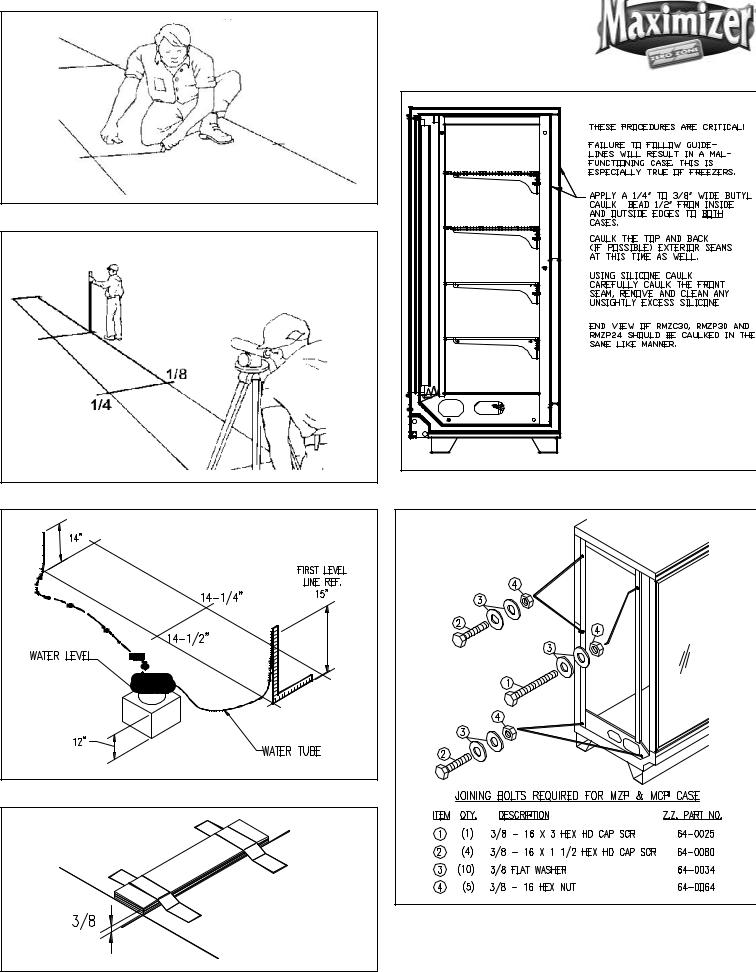
Measure and mark exact case outline
Figure 2: Caulking cases to be joined
Mark floor level differences
Water level elevation points
Figure 3: Joining 24” Door Reach-In Freezers
Shim joints to equal highest points
2 |
RMZC30, RMZP30, RMZP24 |

Joining Freezers
These reach-In freezers have been engineered for continuous display. This means that any number of cases can be joined together to create a display of any desired length. Reach-In freezers are built on permanent steel skids to promote easy installation. The cases can be moved on pipe rollers or with a Johnson Bar. The ends of the case are protected with a removable steel plate.
To install Reach-Ins, perform the following steps:
1.Set the first Reach-In into the desired position and level it. Run a 3/8-inch diameter bead of Butyl caulk 1/2 inch in from both the inner and outer surfaces of the case end. (See Figure 2)
2.Push the second Reach-In against the end of the first. Level the second Reach-In. Remove the left
and right end coil covers and the rectangular pocket hole covers, accessing the holes in the end panels of each freezer as shown. (See Figure 3 for 24” door cases and Figure 4 for 30“ door cases). Install tee strips between the doorframes at case joints on 30” door cases. ( See Figure 5) Use the special screws and nuts provided.
3.Start the joining bolts, but do not tighten them. Begin tightening the bolts at the top rear, working down the back of the case and up the front making sure that the front seams are flush.
Drain Line
The drain is located at the center of the freezer in the floor pan. On all 30” door cases, the drain can be reached by removing the center coil covers. A plastic access cover can then be removed from the fan housing. On all 24” door cases, a small center cover can be removed to access the drain. The 1-inch PVC drain outlet is located at the center front of the freezer behind the kick plate.
Install a tee to the outlet pipe and a PVC drain trap to the tee. Plug the open end of the tee using the cleanout plug supplied with the drain trap kit. The drain line must be pitched away from the case a minimum of 1/4 inch per foot. The tee, drain trap, and plug are supplied standard with the case.
Cart Bumper
The cart bumper should be installed at the bottom front of the case. (See Figure 6) The assembly is adjustable to compensate for uneven floors.
Center and hook the bumper assembly on the hangers provided.
In continuous line-ups, place a kick plate joint strip at each joint. On case ends, lineup an end kick plate with the front mounting holes. Fasten the rear of the end kick plate to the case using TECH screws.
Slide the front kick plate behind the bumper assembly and in front of the end kick plate or kick plate joint strip. Install three screws (two screws on 2-door only) to hold the kick plate and bumper in place. The screws attach the kickplate to a bracket with a timmerman.
A bumper joint strip can be installed over the bumper at the joints. This is standard on Euro Style Trim and optional on Classic Style Trim.
REFRIGERATION
General
Unless otherwise specified, the liquid and suction connections are made inside the case under the evaporator fan/coil cover. Refrigerant piping may enter the case through the front left bottom. (See Figure 10, 11, and 12) Alternate locations are out the left rear bottom of case or left rear top of case. After connections have been made, the refrigeration access hole in the freezer must be sealed completely with aerosol-dispensed Urethane insulation or equivalent (ie: great stuff).
3 |
RMZC30, RMZP30, RMZP24 |
|
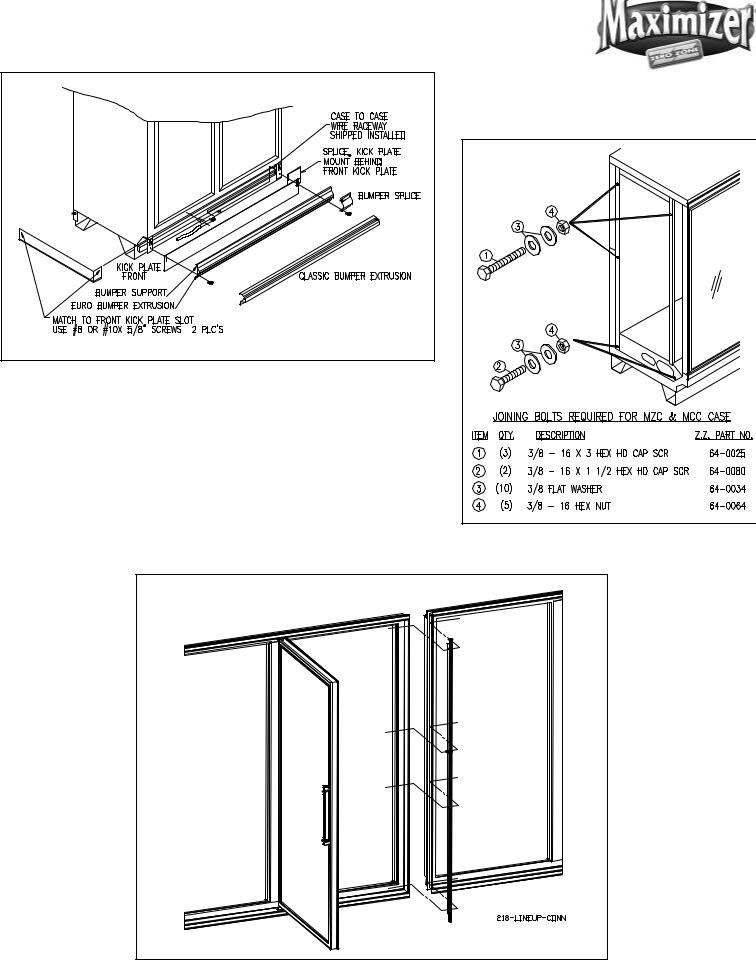
Figure 6: Installing The Cart Bumper
Figure 4: Joining 30” Door Reach-In Freezers
Figure 5: Installing Tee Strips
4 |
RMZC30, RMZP30, RMZP24 |

Refrigerant Piping
Correct refrigeration line sizing and installation is essential for proper system operation. The following tables (Tables 1 through 8) list R502, R404A, R507, and R-22 line sizes for different combinations of frozen food and ice cream freezers. A P-trap must be installed at the bottom of all vertical suction risers.
When two or more freezer sections are connected to one compressor, the main liquid and suction line for the group should be run through the freezers and brought out through the refrigeration outlet of one freezer only. A piping chase allows the refrigerant lines to be run out of the right or left end frame.
The compressor should be installed as close as possible to the freezers to reduce pressure drop. If the compressor is located above the freezer, check the refrigerant line size tables (Tables 1 through 8) in the back of this manual to determine the riser line size. Install a shallow trap at the bottom of the riser. Use a flexible connection (vibration eliminator) between the suction line and compressor.
The suction and liquid lines may be taped together to form an external heat exchanger. Insulate the tubing for at least 20 feet from the freezer outlet.
The best location for the liquid line drier is inside the freezing compartment. However, it may be installed near the compressor for easy maintenance. Install moisture indicating sight glass at the outlet end of the drier.
Temperature Control
A low pressure or temperature control can be used to control freezer temperature. The control should be selected with adequate contact capacity for the switching load. In rack systems, an evaporator pres- sure-regulating valve may be used to control the evaporating temperature.
The settings (See Figure 7) are approximate due to variations in gauge accuracy, differences in compressor efficiency, line pressure drop and super
|
|
|
Frozen Food |
|
||
|
|
|
|
|
|
|
|
|
Pressure |
|
RETURN |
||
|
|
(psig) |
|
|||
|
|
|
AIR |
|||
|
|
|
|
|
|
|
|
R-22 |
R502 |
R404A |
R507 |
TEMP. |
|
Cut In |
24 |
31 |
|
33 |
35 |
+2°F |
Cut Out |
14 |
19 |
|
21 |
22 |
-4° F |
|
|
|
|
Ice Cream |
|
|
|
|
|
|
|
||
|
|
Pressure |
|
RETURN |
||
|
|
(psig) |
|
|||
|
|
|
AIR |
|||
|
|
|
|
|
|
|
|
R-22 |
R-502 |
R404A |
R507 |
TEMP. |
|
Cut In |
19 |
25 |
|
26 |
28 |
-5°F |
Cut Out |
9 |
14 |
|
15 |
17 |
-11°F |
Figure 7: Temperature Control Settings
heat settings. Before making adjustments for store or stocking conditions, make sure the super heat is set between 6°F and 10°F.
Temperature Control Adjustment
When factory installed, the temperature control is located toward the right end of the freezer behind the black kick plate. The sensing bulb is located under the coil cover inside the cabinet. It should be wired in series with the low-pressure (L.P.) control. The wiring diagram (Figure 16) shows use of the thermostat in a pump down system. (Figure 8) shows two types of temperature controls.
Leak Check-Evacuation-Charging
After all of the refrigeration piping and system components have been assembled, the entire system must be pressurized and checked for leaks. Use nitrogen and refrigerant vapor to check for leaks. A Halide leak detector or an electronic leak detector is recommended.
If the system is sealed, evacuate with a deep vacuum pump. Triple evacuation to a minimum of 500 microns and nitrogen sweep is recommended. After the system has been thoroughly evacuated of all moisture and non-condensable gas, charge the system with the proper refrigerant, using “hi-side/low-side” charging techniques.
5 |
RMZC30, RMZP30, RMZP24 |
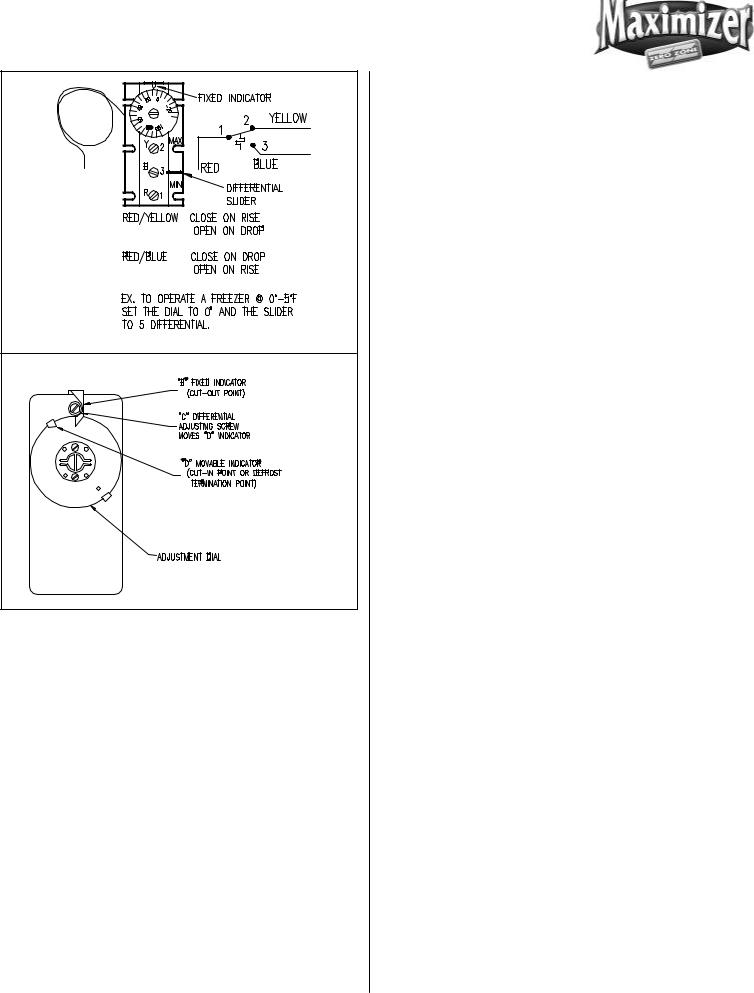
Figure 8: Typical Temperature Controls
Figure 14 shows the typical wiring diagram for a freezer equipped with electric defrost. Figure 15 shows the typical wiring diagram for a freezer equipped with hot gas defrost. Each case is provided with a wiring diagram located in the electric box that shows the exact wiring of the case.
Figure 16 shows the typical wiring of one case with the standard temperature terminating defrost control. The defrost heaters will de-energize when the defrost termination control has been satisfied.
There are many control options available for multiple case defrost systems. Wiring diagrams and instructions can be obtained by calling Zero Zone’s Service Department.
External wiring should be sized according to the amperage rating stamped on the serial plate. The
Figures 10, 11, and 12. All internal wiring has been done at the factory. It has been terminated in the electrical compartment located behind the kick rail at the right end of the case. A terminal block has been used to simplify field connections.
The line side of the contactor is energized with 115 volts at all times. The 115-volt loads in the freezer are energized at all times except during defrost and during post-defrost pulldown. The 208/230 volt defrost element is OFF at all times except during defrost. The time clock is in operation at all times.
Note: All wiring must comply with the National Electrical Code and all local codes.
DEFROSTING
General
Periodic defrosting to keep the coil free of frost is accomplished automatically by a time clock used in conjunction with an electric, hot gas, or reduced temperature gas injection defrost system. The most reliable and efficient defrost system for a single case uses a time clock that incorporates a defrost termination device. Time clocks can be purchased that terminate on coil temperature or case coil pressure. These clocks have the ability to match the defrost time to the frost load on the coil. Coil temperature is sensed by the defrost termination thermostat supplied as standard on all Zero Zone freezers. Pressure terminating clocks generally have the pressure switch built into the time clock. A time clock can be purchased from Zero Zone or from a local refrigeration supply house.
6 |
RMZC30, RMZP30, RMZP24 |
|
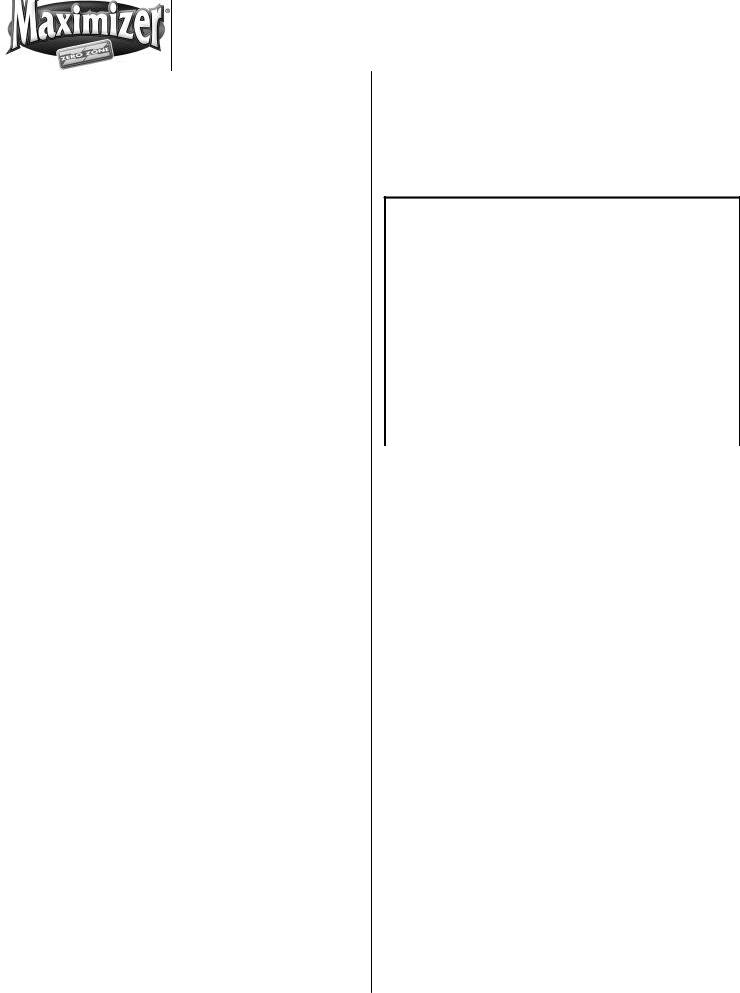
Electric Defrost
When the pin in the 24 hour dial reaches the TIME arrow, the clock will trip and the defrost cycle will start. At that time, the clock will stop the compressor, energize the 208/230 volt defrost heater, and energize the normally closed 208/230 volt contactor. This deenergizes the 115-volt fans, lights, and anti-sweat heaters.
After the defrost period, the compressor will operate. When the coil temperature reaches +5°F, the fan, light and anti-sweat heater limit thermostats will close, starting the fans, lights and anti-sweat heaters.
Gas Defrost
Several types of gas defrost methods in conjunction with time actuated, time or temperature terminated defrost timers can be used to defrost the evaporator.
The refrigeration system designer and installer are responsible for correct line sizing for effective gas defrost and liquid return from the freezers. Sizing and component selection depend on the type of defrost, size, and location of high side refrigeration system.
Zero Zone freezers equipped for gas defrost consist of a side port, distributor and check valve for coil defrost, and a check valve and serpentine coil attached to the bottom of the pan to ensure pan and drain defrost.
Liquid and suction line connections are made inside the case, through the refrigeration access hole located in the floor pan on the left side of the freezer.
The timer starts the gas defrost cycle by energizing a solenoid, reversing valve, or directional valve. The gas is injected from the source into the suction line of the evaporator to be defrosted. The gas flows into the serpentine coil attached to the floor of the case and into the evaporator. Condensed liquid leaves the evaporator through the side port distributor, through a check valve into the liquid line.
Liquid condensed in the serpentine passes through a check valve into the liquid line. (See Figure 18 and 20)
Refer to the defrost frequency and termination recommendations that follow on Figure 9.
TEMPERATURE/PRESSURE TERMINATION
|
Reduced Temp. |
Hot Gas |
Electric |
|
Gas Defrost |
||
|
|
|
|
Frequency |
1 |
1 |
1 |
Temp.(°F)** |
50 |
50 |
50 |
Pressure |
Saturated Suction Pressure Equal to 50 ° F. |
||
Fail Safe |
|
|
|
Time (Min.) |
40 |
30 |
54 |
Drain |
|
|
|
Time (MIn.) |
0-3 |
0-3 |
0 |
|
|
|
|
|
TIME ONLY TERMINATION |
|
|
Time (Min.) |
14-22 min. |
12-20 min. |
40-45 min. |
Drain Time |
0-3 |
0-3 |
0 |
Figure 9: Defrost Frequency and Termination
Refrigeration technician should recheck coil condition after one week of operation to be certain that the frequency and duration of defrost is adequate for the particular store and locality. For example, if defrost voltage is below 200 volts, additional failsafe time may be required.
Temp. termination thermostats should be wired in series for multiple evaporator installations.
Limit Thermostat
Each freezer has factory set limit thermostats attached to the return bends of the coil on the right end of the freezer to regulate the operation of the evaporator fans, freezer lights, and anti-sweat heaters.
OPERATION OF THE LIMIT THERMOSTATS CAUSES THE EVAPORATOR FANS, FREEZER LIGHTS, AND ANTI-SWEAT HEATERS TO REMAIN OFF UNTIL THE COMPRESSOR IS OPERATING AND THE COIL TEMPERATURE IS BROUGHT BELOW THE THERMOSTAT CUT-IN SETTING (+5°F ).
When the freezer first operates, the fans and lights may cycle off and on a few times until coil temperature is below +5 degrees F .
7 |
RMZC30, RMZP30, RMZP24 |
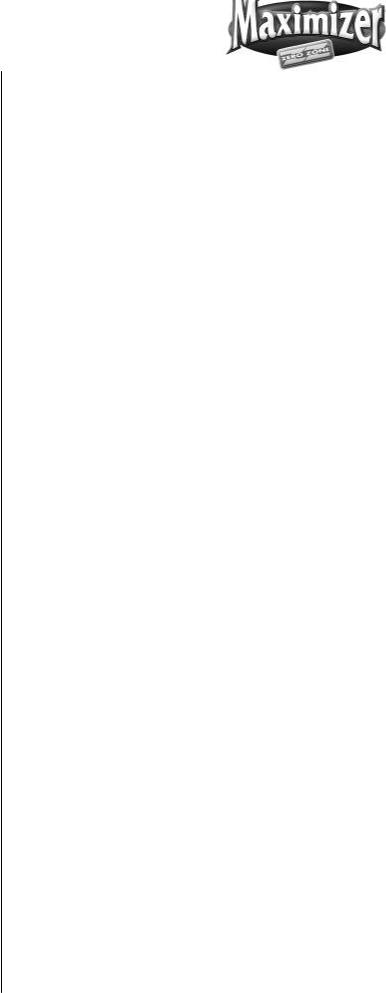
USER INFORMATION
Cleaning
The freezer should be thoroughly cleaned before startup and routinely thereafter to maintain a clean appearance. Use mild detergent and warm water (never an abrasive cleaner) to wipe out the inside of the freezer. Wash down all glass doors with glass cleaner. The freezer will remain bright and sparkling with just a few minutes of cleaning each week. The case drain should be regularly cleared of debris and price tags.
Note: Do not use high-pressure water or steam to clean the interior.
Shelf Location
The shelves are adjustable in 1-inch increments on cantilever shelf cases and 1/2-inch increments on pilaster cases and may be located in any position for best display advantage.
Be sure shelf clips or brackets are completely seated before installing the shelf.
Loading the Freezer
The freezer may be loaded with merchandise after it has been operated for at least 24 hours with correct case temperature and proper control operation. While loading the shelves, leave at least 1 1/2 inch between the top of the merchandise and the shelf above it so the customer can remove the merchandise. The 1 1/2- inch space allows an air curtain on the top of the product.
Light Switch
The light switch is located on the mullion by the hinge side right hand door. Turn the light switch off during the initial freezer temperature pull-down to prevent the freezer lights from cycling off and on. Always turn the lights off when replacing lamps.
SERVICE
See Figures 17 and 18 for the typical component layout of the 30” door case. See Figures 19 and 20 for the typical component layout of the 24” door cases.
Cart Bumper
The cart bumper must be removed to gain access to the drain clean out and electrical connection. Disassemble the bumper and black kick rail by removing the 2 or 3 metal screws located in the kick rail. The bumper assembly can be lifted up and removed from the case. The kick plate can be removed, exposing the electric tray cover and drain. (Figure 6 shows the bumper assembly)
Evaporator
The evaporator coil, located at the rear bottom of the freezer, is factory assembled with distributor, expansion valve, and heat exchanger. To inspect the 30” door coil, remove the center or left of center coil cover. A small inspection port is located at the rear of the case. To inspect the entire 30” coil, remove the remaining coil covers and raise the evaporator cover.
The coil on the 24” door cases accessed by removing the screws from the coil cover. Rotating it at the rear integral hinge can raise the cover.
Expansion Valve
Unless otherwise specified, an externally equalized thermostatic expansion valve with pressure limiting charge adjustable super-heat and thermal bulb is mounted to the evaporator coil. Adjust the super-
8 |
RMZC30, RMZP30, RMZP24 |
